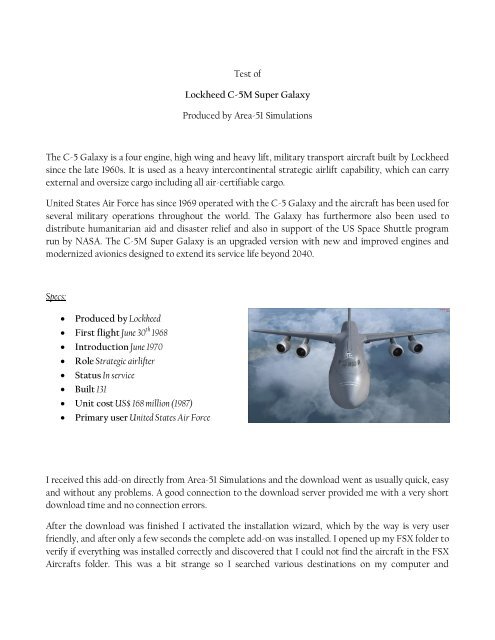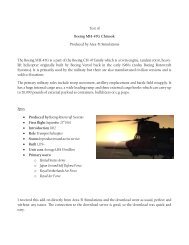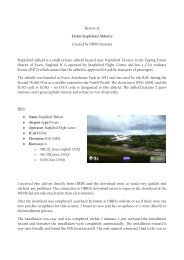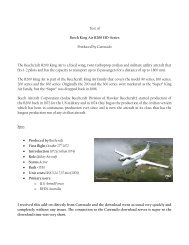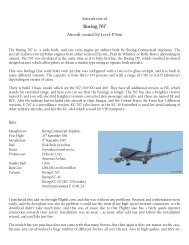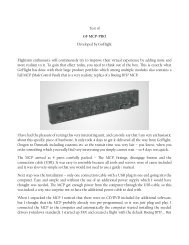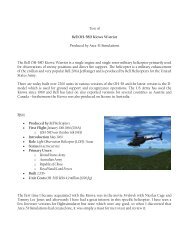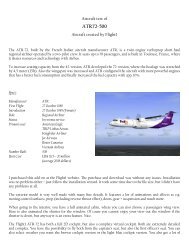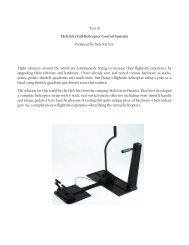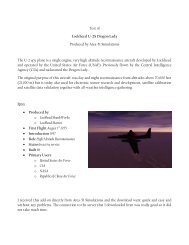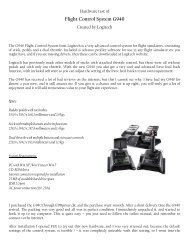Area-51 Simulations Lockheed C-5M Super Galaxy - Rays Aviation
Area-51 Simulations Lockheed C-5M Super Galaxy - Rays Aviation
Area-51 Simulations Lockheed C-5M Super Galaxy - Rays Aviation
Create successful ePaper yourself
Turn your PDF publications into a flip-book with our unique Google optimized e-Paper software.
Test of<br />
<strong>Lockheed</strong> C-<strong>5M</strong> <strong>Super</strong> <strong>Galaxy</strong><br />
Produced by <strong>Area</strong>-<strong>51</strong> <strong>Simulations</strong><br />
The C-5 <strong>Galaxy</strong> is a four engine, high wing and heavy lift, military transport aircraft built by <strong>Lockheed</strong><br />
since the late 1960s. It is used as a heavy intercontinental strategic airlift capability, which can carry<br />
external and oversize cargo including all air-certifiable cargo.<br />
United States Air Force has since 1969 operated with the C-5 <strong>Galaxy</strong> and the aircraft has been used for<br />
several military operations throughout the world. The <strong>Galaxy</strong> has furthermore also been used to<br />
distribute humanitarian aid and disaster relief and also in support of the US Space Shuttle program<br />
run by NASA. The C-<strong>5M</strong> <strong>Super</strong> <strong>Galaxy</strong> is an upgraded version with new and improved engines and<br />
modernized avionics designed to extend its service life beyond 2040.<br />
Specs:<br />
Produced by <strong>Lockheed</strong><br />
First flight June 30 th 1968<br />
Introduction June 1970<br />
Role Strategic airlifter<br />
Status In service<br />
Built 131<br />
Unit cost US$ 168 million (1987)<br />
Primary user United States Air Force<br />
I received this add-on directly from <strong>Area</strong>-<strong>51</strong> <strong>Simulations</strong> and the download went as usually quick, easy<br />
and without any problems. A good connection to the download server provided me with a very short<br />
download time and no connection errors.<br />
After the download was finished I activated the installation wizard, which by the way is very user<br />
friendly, and after only a few seconds the complete add-on was installed. I opened up my FSX folder to<br />
verify if everything was installed correctly and discovered that I could not find the aircraft in the FSX<br />
Aircrafts folder. This was a bit strange so I searched various destinations on my computer and
discovered that the aircraft had been installed directly in the main FSX folder and not in the correct<br />
subfolder. I found all files and manually moved them to the correct subfolder to get the add-on<br />
working in FSX.<br />
I now opened up FSX to check my virtual hangar to see if I had found and moved all files. I had and<br />
now the aircraft was perfectly shown in my virtual hangar together with the other add-ons that I have<br />
from <strong>Area</strong>-<strong>51</strong> <strong>Simulations</strong>.<br />
I started my test with a walk-around the outside of the aircraft to check the external model. The model<br />
is indeed very well made and looks very realistic according to the various pictures that I found on the<br />
internet. The aircraft is covered with good quality textures and has a great and realistic finish –<br />
furthermore the aircraft also features lots of details that characterize this specific aircraft as e.g. the<br />
wings and the huge T-tail.<br />
There are many animations such as various control surfaces, door, loading ramp, wheels turning, nose<br />
wheel steering, suspension, gear up/down and several others, and they are all very nicely created. The<br />
lights are placed in accordance with pictures of the real C-5 and the light effect is made very well with<br />
a clear and bright shine.
After the outside walk-around I went inside this huge beast of an aircraft and found both a 2D and a<br />
virtual cockpit. The 2D cockpit is fair and features a realistic cockpit with various animated buttons<br />
and switches together with various systems and in general a good and useable 2D cockpit.<br />
The virtual cockpit is good with fair quality textures, really superb depth, good quality gauges, various<br />
animated buttons and switches and a nice and clean finish around all edges. In the virtual cockpit you<br />
also have animated controls and various systems and overall the general atmosphere seems quite<br />
realistic.<br />
The sound set included in this model is good. You have various standard environmental sounds that<br />
add to the realism and the engine sound is very similar to the real <strong>Galaxy</strong> according to sound clips that<br />
I found on the internet of the real <strong>Galaxy</strong>. I tested the sound set in both stereo and 7.1 surround sound<br />
and both settings worked perfectly.<br />
I tested this aircraft on several flights and found it to be a very interesting aircraft. The flight dynamics<br />
resembles the default Boeing B747 with a twist which I think is quite realistic. I have of course never<br />
tried to fly this aircraft in real life, but when I compare the flight dynamics for this <strong>Galaxy</strong> to the data<br />
files I could find of the real <strong>Galaxy</strong>, than I would believe it to be quite accurate and realistic.
This aircraft can be used for several missions both in military operations but also as a civilian transport<br />
aircraft. I set up 2 different missions for my tests of this <strong>Galaxy</strong>. First I wanted to get a feeling of the<br />
aircraft, so my first mission was a troop and cargo transport from Nellis AFB to Edwards AFB. On this<br />
flight I tested the ground handling, in flight characteristics, approach and landing and the autopilot.<br />
To handle this huge monster aircraft requires patience and skills. This is an aircraft bigger than the<br />
Boeing B747 and you have to be very careful when turning the aircraft. The cockpit it placed high<br />
above the ground and quite a bit in front of the nose wheel. Furthermore the aircraft is very long and<br />
very wide which requires that the pilot has to calculate every turn very precisely to keep the aircraft<br />
centered on the taxiway and not slip off and onto the grass. If that were to happen in real life you<br />
would probably get stuck there due to the enormous weight of the aircraft.<br />
Throttling up and going down the runway is on the other hand very easy. The aircraft is extremely<br />
steady and the engines have a good amount of thrust so you have no problems reaching your take-off<br />
speed. Rotating the aircraft is like rotating a Boeing B747 and when you pitch up app. 10 degrees you<br />
get airborne.<br />
The general flight dynamics are as described earlier, quite similar to the Boeing B747 or other aircrafts<br />
this size. The <strong>Galaxy</strong> is not super fast on the control surfaces, so you do need to plan ahead, but other<br />
than that, the flight dynamics are very realistic and the aircraft is flown with ease.<br />
The autopilot requires some time to get used to, but if you are used to fly heavy bird on autopilot (as<br />
the B747) than would will very quickly get used to the <strong>Galaxy</strong>. The autopilot is not completely similar<br />
to the B747 but it is still very user friendly and simple.<br />
Flying the approach and landing the <strong>Galaxy</strong> does require patience from the pilot. You do need to make<br />
a slow descent and come in on a long final, but if you do that you will have absolutely no problems<br />
landing this huge aircraft. In general I would say that this aircraft can be flown by simmers on a level of<br />
intermediate and if you are used to fly heavy airliners, then this aircraft will not be that difficult to<br />
learn to fly.
My second test flight was a civilian transport flight from O’Hara Intl, USA to Billund Intl, Denmark.<br />
On this test I got to experience the <strong>Galaxy</strong> on a long flight and at maximum altitude. This flight was<br />
just as if I had flown a regular heavy jet airliner but still if was much fun live in-to the role of a <strong>Galaxy</strong><br />
pilot. The most special thing about the <strong>Galaxy</strong> I would say is the view from the cockpit. When sitting<br />
in the captains seat and looking at the buildings around you when taxiing, you can really see how high<br />
your seat is placed according to the ground. This was something that I really had to get used to, and<br />
this of course will also be a tricky part when landing because you do need to flare quite high according<br />
to your view from the cockpit.<br />
In general this huge aircraft is very well made with lots of details and a great external finish. The<br />
textures used are good quality both for the external model but also for the virtual cockpit. The model<br />
and virtual cockpit features various animation that are all very nicely made and the light effect is also<br />
good quality. The sound set included fit the model and overall the <strong>Galaxy</strong> is very realistic also when<br />
looking at the flight dynamics.<br />
I rate this add-on aircraft 3½/5-stars and thank <strong>Area</strong>-<strong>51</strong> <strong>Simulations</strong> for this very special huge beast. It<br />
was really a pleasure to test and review the <strong>Galaxy</strong> because there are not many payware versions of<br />
this specific aircraft.<br />
<strong>Rays</strong> <strong>Aviation</strong>
Variants<br />
C-5A<br />
The original version from 1969 to 1973<br />
C-5B<br />
The C-5B is an improved version of the C-5A. It incorporated all modifications and improvements<br />
made to the C-5A with improved wings, simplified landing gear, upgraded TF-39-GE-1C turbofan<br />
engines and updated avionics<br />
C-5C<br />
The C-5C is a specially modified variant for transporting large cargo. Two C-5s (68-0213 and 68-0216)<br />
were modified to have a larger internal cargo capacity to accommodate large payloads, such as<br />
satellites for use by NASA. The major modifications were the removal of the rear passenger<br />
compartment floor, splitting the rear cargo door in the middle, and installing a new movable aft<br />
bulkhead further to the rear. The official C-5 technical manual refers to the version as C-5A (SCM)<br />
Space Cargo Modification. Modifications also included adding a second inlet for ground power, which can<br />
feed any power-dependent equipment that may form part of the cargo<br />
C-5 AMP and C-<strong>5M</strong> <strong>Super</strong> <strong>Galaxy</strong><br />
Following a study showing 80% of the C-5 airframe service life remaining, AMC began an aggressive<br />
program to modernize all remaining C-5Bs and C-5Cs and many of the C-5As. The C-5 Avionics<br />
Modernization Program (AMP) began in 1998 and includes upgrading avionics to Global Air Traffic<br />
Management compliance, improving communications, new flat panel displays, improving navigation<br />
and safety equipment, and installing a new autopilot system. The first flight of a C-5 with AMP (85-<br />
0004) occurred on 21 December 2002<br />
The Reliability Enhancement and Re-engining Program (RERP) began in 2006. It includes new<br />
General Electric F138-GE-100 (CF6-80C2) engines, pylons and auxiliary power units, upgrades to<br />
aircraft skin and frame, landing gear, cockpit and pressurization systems. The CF6 engine produces<br />
22% more thrust (for 50,000 lbf/220 kN) from each engine, providing a 30% shorter takeoff, a 38%<br />
higher climb rate to initial altitude, an increased cargo load and a longer range. Upgraded C-5s are<br />
designated C-<strong>5M</strong> <strong>Super</strong> <strong>Galaxy</strong>.


